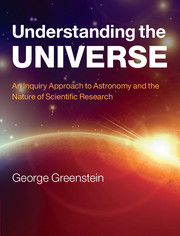Book contents
- Frontmatter
- Contents
- Preface
- Acknowledgments
- Part I Introducing steps to astronomy
- Part II The Solar System
- 6 Introducing the Solar System
- 7 The inner Solar System
- 8 The outer Solar System
- 9 Smaller bodies in the Solar System
- 10 Planets beyond the Solar System
- Part III Introducing stars
- Part IV Introducing galaxies and the Universe
- Epilog
- Appendix I The small-angle formula
- Appendix II Exponential notation
- Appendix III The Solar System
- Appendix IV The closest and brightest stars
- Appendix V Physical and astronomical constants
- Appendix VI Conversion factors
- Appendix VII Constellation maps
- Glossary
- Figure Credits
- Index
- Plate section
9 - Smaller bodies in the Solar System
from Part II - The Solar System
Published online by Cambridge University Press: 05 February 2013
- Frontmatter
- Contents
- Preface
- Acknowledgments
- Part I Introducing steps to astronomy
- Part II The Solar System
- 6 Introducing the Solar System
- 7 The inner Solar System
- 8 The outer Solar System
- 9 Smaller bodies in the Solar System
- 10 Planets beyond the Solar System
- Part III Introducing stars
- Part IV Introducing galaxies and the Universe
- Epilog
- Appendix I The small-angle formula
- Appendix II Exponential notation
- Appendix III The Solar System
- Appendix IV The closest and brightest stars
- Appendix V Physical and astronomical constants
- Appendix VI Conversion factors
- Appendix VII Constellation maps
- Glossary
- Figure Credits
- Index
- Plate section
Summary
Planets are not the only bodies orbiting the Sun. The Solar System also contains innumerable smaller bodies: meteoroids, asteroids and comets. We now turn to a study of these.
We have already commented on how common craters are in the Solar System. Our Moon is covered with them, as are many other moons and planets. Indeed, the Earth is unusual in having so very few craters. As we have already mentioned, this is not because the Earth never had craters: it is because they have been “erased” by erosion and other geological processes.
Once in a long while these impacts are catastrophic. Indeed, we believe it was just such an impact that led to the extinction of the dinosaurs. Only highly sensitive and highly accurate observations are capable of telling us whether an incoming body poses a similar threat today. Efforts are under way to study the feasibility of deflecting any such potentially threatening objects that we might discover.
Meteors
Meteor showers
Several times each year a meteor shower occurs. Perhaps you have seen one. They can be very beautiful as, utterly soundlessly, meteors streak across the sky. Sometimes a particularly large one will leave a faint glowing trail. The meteoroids that produce these showers are tiny – about the size of snowflakes. Because they are so small they entirely burn up in their fiery passage through the atmosphere: none of them survives to reach the ground. During a particularly intense shower you might see one a minute, although occasionally even greater rates are seen.
- Type
- Chapter
- Information
- Understanding the UniverseAn Inquiry Approach to Astronomy and the Nature of Scientific Research, pp. 248 - 295Publisher: Cambridge University PressPrint publication year: 2013



